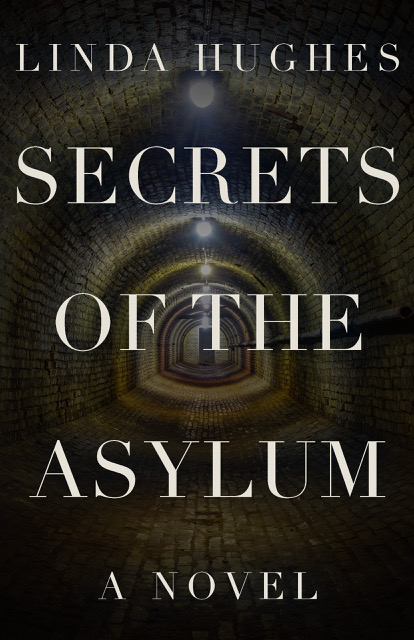Author: Linda Hughes
Thanks to MyNorth for including Secrets of the Asylum in books to read


Brides and Brooms

Halloween is almost upon us and I swear I’ve been haunted by articles about how ghastly midlife is for GenX women. I’ve been shown or accidentally run into three such missives lately that claim that it’s worse for them than it has ever been for anyone else.
Poppycock.
Where have those writers been for forty years? Apparently not paying attention to history, or talking to their elders, or doing enough homework to know that for eons women have been complaining about midlife, a time of life when things go awry on the bad hand and new awakenings occur on the good hand.
Realizing you’ve hit the halfway point of your life can indeed be daunting. But it’s nothing new. Especially for a woman who’s been busy juggling work, a home, and a family. No age group has the corner of the angst that can cause for some people. Scales of “happiness” were quoted, with women supposedly being more unhappy now than ever before. Oh please! The only difference is that today social media advertises a person’s unhappiness. We used to be expected to just keep it bottled up.
One article noted the incidence of divorce being higher than for generations past. Of course it is. Women now have the social, religious, legal, and economic means for getting divorced. They didn’t have that in the past. More divorce isn’t a measure of more unhappiness, it’s a measure of more freedom to get divorced when you’re unhappy.
In the 1980’s I did seminars for women about life’s transitions. I wrote a book called Surviving the Superwoman Syndrome. Then I wrote Action Plans: A Women’s Survival Guide. In the early 2000’s I did my Doctoral dissertation on self-development for midlife women and published LifeMaps for Midlife Women. I certainly wasn’t the first to address this issue. In my time there have been Betty Friedan, Gloria Steinem, bell hooks, and so many others. I’m wondering if those writers have even heard of them.
Do I think that all GenX midlife women think they have it worse than anyone else? Of course not. My hope is that they’ll start writing and share their important stories, too. We’re all in this together and need to help each other out.
Instead of haunting each other this Halloween, let’s celebrate our commonalities. And, most of all, let’s dance around the fire and have a good time.
Secrets of the Island

 Mackinac Island is one of my favorite places on earth. I’ve worked in 13 countries and traveled to a couple dozen more, many spectacular; but, still, that speck in Lake Huron in Michigan, U.S.A., remains one of my favorite places to visit. A native Michigander, I’ve been going there since I was a kid.
Mackinac Island is one of my favorite places on earth. I’ve worked in 13 countries and traveled to a couple dozen more, many spectacular; but, still, that speck in Lake Huron in Michigan, U.S.A., remains one of my favorite places to visit. A native Michigander, I’ve been going there since I was a kid.
The only way to get there is by ferry. No motorized vehicles are allowed on the island, except emergency vehicles. Therefore, if you want to get around you walk, ride a bike, ride a horse, or hire a carriage. It’s like stepping back a hundred and fifty years in time.
 The small Victorian-era village is charming as all get-out. American flags dot the landscape. There are many Queen Anne, Gothic, Revival, Shingle, and other styles of “cottages,” which range in size from small to huge. Quaint inns, B&Bs, churches, and shops abound. The Grand Hotel, with the longest veranda in the country, is king of the hill. With its panoramic views of Lakes Huron and Michigan, it attracts visitors from around the globe.
The small Victorian-era village is charming as all get-out. American flags dot the landscape. There are many Queen Anne, Gothic, Revival, Shingle, and other styles of “cottages,” which range in size from small to huge. Quaint inns, B&Bs, churches, and shops abound. The Grand Hotel, with the longest veranda in the country, is king of the hill. With its panoramic views of Lakes Huron and Michigan, it attracts visitors from around the globe.
The popular 1980 timeslip movie Somewhere in Time, starring Jane Seymour and Christopher Reeve, was filmed at the Grand and still has a large following. If you’re a fan of the movie like I am, every time you step into that hotel you’ll be struck by the emotional story of two lovers from different centuries.
The history of the island is fascinating, as well. Native Americans were there first, of course, with evidence of semi-nomadic people as early as 1000 B.C. Anishnaabek tribes inhabited the area when French fur traders arrived in the 1600s. French missionaries followed, trying to save the souls of the native peoples and the rowdy fur traders. An assortment of scallywags showed up, too. In 1761, after the French and Indian War, the British took over Fort Michilimackinac, which the French had built on the mainland. In 1779 the British and civilians moved the fort to the island. After winning the Revolutionary War, the United States took over the island and the fort in 1796. But in 1812 the British captured the fort.
Rumor has it most of the American soldiers escaped to the mainland, with wives and children left behind at the fort. A few years later, 1815, when the American soldiers finally were able to take back the fort, not all the wives were happy. One or two liked the Brits better than their American husbands.
What all of the means is that the fort was orginally French, then British, then American, then Brithish, then American again. Whew. Think of how that impacted the native peoples.
Finally, that part of North America officially belonged to the U.S.A. and the rest is history. The fort still stands, with reenactments throughout the summer. Well, not of the unhappy wives, but of the soldiers.
 It’s an 8.2-mile journey around the island, an easy bike ride, as it’s mostly flat along the shoreline. You can also ride through the hilly inland part of the island if you’re fit for a hefty trek. There are caves, cemeteries, rock formations, and other things to see along the way. It’s tradition to build a cairn out of rocks on the shorline, so make sure you leave yours behind. A cairn is stacked rocks that tell the world you were there. Weather knocks them down, so you have to come back to build anew.
It’s an 8.2-mile journey around the island, an easy bike ride, as it’s mostly flat along the shoreline. You can also ride through the hilly inland part of the island if you’re fit for a hefty trek. There are caves, cemeteries, rock formations, and other things to see along the way. It’s tradition to build a cairn out of rocks on the shorline, so make sure you leave yours behind. A cairn is stacked rocks that tell the world you were there. Weather knocks them down, so you have to come back to build anew.
A cairn is on the cover of my new romantic suspense novel, Secrets of the Island. You guessed it: the story takes place on Mackinac Island. I’m thrilled to have finally written a book about this fascinating place. It’s 1943 and a Red Cross nurse sequesters herself in her grandfather’s cottage to escape the ravages of what she experienced in the war. However, one family secret after another emerges to remind her that she’s not the only one with secrets to bear.
 Here’s my invitation to you: go to Mackinac Island. Visit the Island Bookstore and get Secrets of the Island. Find a nice seat on a porch facing the lake and have a refreshment at hand as you read. If you can’t go in person, let the book take you away as you slip back in time.
Here’s my invitation to you: go to Mackinac Island. Visit the Island Bookstore and get Secrets of the Island. Find a nice seat on a porch facing the lake and have a refreshment at hand as you read. If you can’t go in person, let the book take you away as you slip back in time.
This story will make you wonder: what secrets are buried in your family tree?
The Three Amigos

I have a handful of best friends. How about you? I think most of us feel close to a few people, not hoards.
Today I want to talk about two of my sister-friends, Myra and Marka. We call ourselves the Three Amigos. We’ve known each other for thirty years and joke that we have to stay friends because we know too much. We don’t want anyone telling our deepest, darkest secrets.
When I first met Myra, we went to lunch one day at a Mexican restaurant. A roach crawled up the wall beside us in the middle of her telling a story. Without breaking stride, she took off her shoe, killed the pest, and went on with her story. I knew she was my kind of woman.
Myra introduced me to Marka, who is ten years younger than the other two of us. Beautiful, stylish, Southern as all get-out, and smart as a whip, I fell in love with her, too, as soon as I met her.
We’re all married, so the husband stories have abounded, as you can well imagine. We love our families but treasure our time together. We meet informally for lunch throughout the year, but it’s tradition to meet before Christmas for a long lunch to exchange small gifts, and then wander through an antique store or two.
It’s this friendship I used as a model for my latest novel, Secrets of the Island. A romantic suspense story, the “Three Musketeers” band together to solve a family mystery. When they solve one, another crops up, so they keep going. It takes place during World War II, so wartime issues intertwine with their lives.
As I wrote, I would think of Myra’s effervescent take on life and Marka’s way of turning a phrase. My characters took on their personalities, with someone a lot like me in the middle orchestrating the solving of the mystery.
I think this is what we as writers do. We don’t disclose our friends’ secrets, but we automatically use who and what we know to write. As I wrote about the Three Musketeers, I fell in love with those characters. Do you as a writer fall in love with some of your characters? I hope so. That’s what will make your readers fall in love with them, too.
This writing also made me fall in love with the Three Amigos all over again. Here’s to sister-friends everywhere. May you stay friends forever, holding those secret stories locked away in your heart.
Secrets: Points to Ponder

While creating the trailer for Secrets of the Asylum, I kept rolling over in my mind the comments and questions regarding the book that folks have posed on Facebook and Twitter. So here are some points to ponder, first notes to answer some of your questions about how I came up with this story and then some questions from me to get you thinking about your own reactions to the book.
These questions are great for your own private musings or for public discussion, such as a coffee klatsch or book club. I’ve also included the resources I used to research time and place, in case you’d like to investigate more on your own.
I’d love to read your comments here.
Author’s Notes:
Elizabeth lived in my head for two years before I knew the setting for her story. She’d sink into my thoughts during yoga, while walking my dog, and as I nodded off to sleep at night. Then I toured the former Northern Michigan Asylum and immediately knew that was where she belonged.
I also recognized there were undoubtedly many secrets like hers buried within the walls of that stalwart institution that had harbored the “insane” for almost a century.
When I visited my Aunt Hope, who resided in Cottage 23 after it had become an assisted living facility, I knew that her room, with its spectacular tall ceiling and long windows affording a view of the lush yard, would be Elizabeth’s room during that earlier era.
As soon as I decided it would be Elizabeth’s twenty-one-year-old daughter who would seek out the truth about her mother’s situation and that the year would be 1921, I knew this would be the first book of a trilogy. The second book takes place in 1942 and the third in 1963. Yes, each time a daughter turns twenty-one another romantic suspense tale will be revealed.
Now I’m bursting to tell those stories, Secrets of the Island and Secrets of Summer. So stay tuned. This family’s generations of dark deceptions will come to light one-by-one in 2018 and 2019.
Questions for You:
- What did you think of Elizabeth in the beginning of the book? Did you admire or abhor her bohemian behavior? Why?
- What would you have liked most and least about living in 1921?
- Do you believe in psychics like Abby? Have you visited one? If you have, what’s the most profound reading you’ve ever had?
- Are you aware of how the mentally ill are treated today, now that “asylums” are gone? What would you suggest to improve treatment?
- What do you think should happen in the next book, in 1942 when Meg’s daughter turns twenty-one?
Resources:
This certainly isn’t an inclusive list, as I did a boat-load of research for this book. However, these are the books and documents I found to be most helpful. Naturally, I used many online sources are well, readily available if you search.
- Northern Michigan Asylum for the Insane: A History of the Traverse City State Hospital, by William A. Decker
- Traverse City State Hospital (Images of America), by Chris Decker
- Angels in the Architecture: A Photographic Elegy to an American Asylum (Great Lakes Book Series), by Heidi Johnson and Nancy Tomes
- Beauty is Therapy: Memories of the Traverse City State Hospital, by Kristin M. Hains and Earle E. Steele
- Report of the Board of Trustees of the Northern Michigan Asylum at Traverse City, June 30, 1908
- The Traverse City State Hospital Training School for Nurses, by Virginia M. LeClaire
- Traverse City, Michigan: A Historical Perspective, 1850-2013, by Richard Fidler
- Michigan Railroads & Railroad Companies, by Graydon M. Meints
- Justus S. Stearnes: Michigan Pine King and Kentucky Coal Baron, 1845-1933 (Great Lakes Book Series), by Michael W. Nagle
- Al Capone’s Beer Wars: A Complete History of Organized Crime in Chicago During Prohibition, by John J. Binder
- American Family of the 1920s: Paper Dolls in Full Color, by Tom Tierney
- I readily confess I spent too much time looking at 1920s fashion. It was wonderful!
Digging Up Asylum Secrets

 Writing a book is always more work than I anticipate. I think this is true of many, if not most, writers: I’m struck with a spectacular idea for a story, which is great fun, and then have to sit down and do the actual work. Some writing days are a high of creativity; others are the pits. Most of my days of working on my latest romantic suspense novel, Secrets of the Asylum, were a joy, but others were a depressing drag.
Writing a book is always more work than I anticipate. I think this is true of many, if not most, writers: I’m struck with a spectacular idea for a story, which is great fun, and then have to sit down and do the actual work. Some writing days are a high of creativity; others are the pits. Most of my days of working on my latest romantic suspense novel, Secrets of the Asylum, were a joy, but others were a depressing drag.
What was depressing? Research – a critical part to writing a good book – that revealed some of the practices in the past regarding committing people to asylums. One of my three main characters is in a “loony bin” in 1921, so data collection was necessary, seeing that I was not in such a facility at that time. Some of that information I was already privy to from former research on the one-time asylum in Milledgeville, GA. Then I took a tour of the former Northern Michigan Asylum for the Insane, later the Traverse City State Hospital, and walking through the hallways and bedrooms and tunnels of that huge structure that housed 2,000 people I could feel their sorrows as well as the relief of some to be sheltered away from traditional society. Learning that women were often committed by their husbands just to get them out of the way so that the husbands would be free to run around was maddening. There was even a menopause cottage, the assumption being that a woman couldn’t handle herself during that time of life. And people who were sick, especially if they had consumption (tuberculosis), went there, which wasn’t necessarily the best place for treatment of such a disease.
There were some, however, who wanted to be committed, and that was fascinating to discover. It was reported in asylum records that some women committed themselves to get away from working a farm, husbands, and children. Old lumberjacks who could no longer wield an ax holed away there. Criminals with mental problems were sometimes sent there instead of prison. A woman going through menopause might in fact want to get away from it all. People with mental impairments and disabilities were there. A homeless orphan child and a single mother with kids might need food and shelter. Many used it as home until the end of their lives.
There were even those recorded as being there for “religious fervor” and “sexual misbehavior.” It was an interesting mix, to be sure.
Weaving reality into my fictional story took a lot of thought. It isn’t something that can just be thrown together. This I tell you in case you are a writer or are thinking of being a writer. If you have fairy tale ideas about the glamour of writing, I suggest you find yourself a cozy asylum. A good story takes creativity, dreaming, and imagination, to be sure, but mostly it takes good old-fashioned seat time. You need to sit down and do the work, on enjoyable days and on depressing days. Those books that are living in your head don’t write themselves.